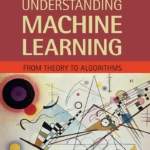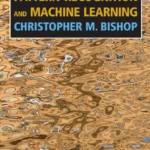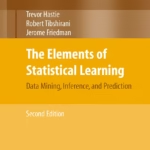
Best AI & Machine Learning Theory Books
The curated list of books here are intended for deepening your theoretical understanding of AI, helping you understand not just how algorithms work, but why they work. They’re standard references behind university ML courses and research programs, focusing on mathematics, proofs, and conceptual principles.
⚠️ Prerequisites: Books here assume comfort with calculus, linear algebra, probability, and basic machine learning concepts. If you’re new to ML, consider starting with our AI & ML Books for Beginners & Intermediates.
Why study theory? Strong mathematical foundations help you:
- Understand when and why algorithms fail
- Design new methods rather than just applying existing ones
- Read and contribute to research literature
- Debug complex systems with principled reasoning
We’ll continue to update this list as new theoretical and research-level books emerge.
Disclosure: This page contains affiliate links.
📖 Book Categories
- General ML Theory
- Deep Learning Theory
Understanding Machine Learning: From Theory to Algorithms (2014) – Shai Shalev-Shwartz & Shai Ben-David (UML)

👉 Check Price on Amazon (affiliate link)
A rigorous and beautifully structured introduction to the theoretical foundations of machine learning. It systematically builds from fundamental concepts like PAC learning, VC dimension, and generalization bounds to core algorithms including SVMs, boosting, and neural networks.
Understanding Machine Learning (UML) focuses on why algorithms work, providing mathematical proofs and formal guarantees for key methods.
✅ Good for:
- Readers with solid math background (linear algebra, probability, calculus)
- Understanding the formal learning theory behind ML
- Gaining insight into the generalization and guarantees of algorithms
⚠️ Weak at:
- Minimal code or practical examples
- Dense notation and proofs – requires dedicated study time
- Limited deep learning coverage (published pre-2016)
👤 Best for: Graduate students and researchers seeking a mathematically rigorous foundation in ML theory
Pattern Recognition and Machine Learning (2006) – Christopher M. Bishop (PRML)

👉 Check Price on Amazon (affiliate link)
A classic reference that bridges statistics and machine learning. PRML takes a Bayesian perspective throughout, covering graphical models, kernel methods, and approximate inference. Despite being published in 2006, it remains the gold standard for understanding probabilistic models and the statistical foundations of ML.
✅ Good for:
- Deep statistical understanding of ML from a Bayesian viewpoint
- Probabilistic graphical models and approximate inference methods
- Clear explanations with helpful visualizations and mathematical derivations
- Foundation for modern probabilistic ML (VAEs, Gaussian processes, Bayesian deep learning)
⚠️ Weak at:
- Published before deep learning – no modern neural architectures
- Heavy mathematical treatment requires dedicated study time
- Limited practical implementation guidance
👤 Best for: Advanced students and researchers who want to understand machine learning as a probabilistic modeling discipline
The Elements of Statistical Learning (2nd Edition, 2009) – Trevor Hastie, Robert Tibshirani, Jerome Friedman (ESL)

👉 Check Price on Amazon (affiliate link)
Written by leading Stanford statisticians, ESL is a rigorous exploration of classical machine learning from a statistical viewpoint. Covers linear and non-linear methods, kernel approaches, model selection, ensemble methods, and boosting, all with clear mathematical derivations and proofs.
It’s the theoretical sibling of An Introduction to Statistical Learning (ISL), but with much greater depth and mathematical rigor.
✅ Good for:
- Deep understanding of the mathematical and statistical foundations of ML
- Readers comfortable with proofs, matrix calculus, and optimization theory
- Comprehensive coverage of classical methods (SVMs, boosting, ensemble methods, kernel methods)
- Building statistical intuition that carries over to modern ML and deep learning
⚠️ Weak at:
- Requires strong mathematical and statistical background
- No deep learning content (published 2009)
- Heavy time investment – dense material requiring careful study
👤 Best for: Advanced students, researchers, and practitioners aiming to master the statistical and theoretical foundations of ML
Deep Learning (2016) – Ian Goodfellow, Yoshua Bengio, Aaron Courville

👉 Check Price on Amazon (affiliate link)
Often called “The Deep Learning Bible”, this is the definitive theoretical textbook on deep learning, written by three leading researchers in the field. Provides comprehensive mathematical foundations covering neural networks, optimization, CNNs, RNNs, and regularization techniques.
✅ Good for:
- Rigorous mathematical foundations and theory
- Understanding the “why” behind deep learning algorithms
- Comprehensive coverage of pre-2016 architectures (CNNs, RNNs, LSTMs)
- Building deep conceptual understanding of core principles
⚠️ Weak at:
- Dense and math-heavy (requires strong calculus, linear algebra, probability background)
- Published before transformers (no coverage of attention mechanisms, BERT, GPT, or modern LLMs)
- Lacks practical implementation guidance and modern frameworks
👤 Best for: Graduate students, researchers, and advanced practitioners seeking a deep theoretical understanding of neural networks and representation learning
Final Thoughts
These books represent the cornerstone of machine learning and deep learning theory, the mathematical and conceptual foundations behind modern AI.
They’re timeless references that reward careful study and offer depth far beyond practical guides.
We’ll continue updating this list as new theoretical works emerge.
If you think something important is missing, feel free to reach out at aipapers@aipapersacademy.com.